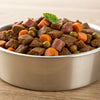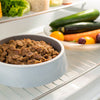Is It Good to Wet Dry Dog Food? A Comprehensive Guide for Pet Owners
- Houndsy
Table of Contents
- Introduction
- Understanding Dry Dog Food
- The Pros of Wetting Dry Dog Food
- The Cons of Wetting Dry Dog Food
- When Should You Consider Wetting Dry Dog Food?
- Practical Tips for Adding Water to Dry Dog Food
- Exploring Mixed Feeding: Wet and Dry
- Conclusion
Introduction
As pet owners, we are constantly looking for ways to enhance our dogs' health and happiness. Consider this: up to 50% of dog owners report that their pets are picky eaters or show a lack of interest in dry kibble. In this context, the question arises: is it good to wet dry dog food? This intriguing query has become a hot topic among dog lovers and nutritionists alike.
Feeding our furry friends is more than just a routine; it carries significant implications for their health and well-being. With various feeding practices and options available, we want to ensure that we are making informed choices. In this blog post, we will delve into the advantages and disadvantages of adding water to dry dog food, helping you understand whether this practice could benefit your pooch and your feeding routine as a whole.
We’ll cover everything from improving your dog’s hydration levels and mealtime enjoyment to the possible risks of spoilage and dental issues. By the end of this article, you will have a clearer understanding of whether wetting dry dog food is an appropriate choice for your dog, and you might even be inspired to try it with your kibble or consider our hero product, the Houndsy Kibble Dispenser, for enhanced convenience and feeding enjoyment.
Understanding Dry Dog Food
Before we jump into the question of whether adding water to dry dog food is a good idea, it’s essential to understand what dry dog food entails. Dry dog food, commonly known as kibble, is the most prevalent form of pet food due to its convenience and widespread availability.
What Is Dry Dog Food?
Dry dog food is typically composed of various ingredients, including meats, grains, vegetables, and supplemental vitamins and minerals. The ingredients are processed through a method called extrusion, where the mixture is cooked, shaped, and dried to create the kibble we are familiar with. Thanks to its lower moisture content—generally sitting around 10% to 12% moisture—dry kibble boasts several advantages, such as:
- Cost-effectiveness: Because it lasts longer and requires less packaging than wet food, it often proves to be more budget-friendly.
- Convenience: Kibble is easy to measure and store, making it an attractive option for busy pet owners.
- Dental health benefits: Chewing dry kibble can help reduce plaque and tartar accumulation, benefiting your dog’s oral health.
But is it really the best choice, or can it be improved upon? Let’s explore what happens when we add water to kibble.
The Pros of Wetting Dry Dog Food
Incorporating water into kibble may seem like a simple adjustment, but it can yield various benefits for our canine companions.
Enhanced Palatability
One of the primary arguments for moistening dog food is that it can significantly enhance its flavor and aroma, making it more appealing. Research indicates that dogs are more likely to eat food that smells fragrant and appetizing. By introducing water, we essentially release the flavors locked in the dry food, creating a more enticing meal experience.
Improved Hydration
Water is essential for every animal's health, including our dogs. Many dogs do not drink an adequate amount of water daily, which can lead to dehydration. Adding water to dry dog food increases the overall moisture content, allowing dogs to consume more fluids indirectly. This can be especially significant for pups prone to urinary or kidney issues.
Easier Digestion
Moistening kibble can soften the food, making it easier to chew and swallow, particularly for senior dogs or those with dental problems. As a result, adding water can help reduce the risk of choking and support a more comfortable mealtime for dogs facing challenges due to age or oral health concerns.
Increased Satiety
For dogs on a diet, wetting their kibble may contribute to a feeling of fullness and help control portion sizes better. Soaked kibble can expand in the stomach, providing that satiating feeling with fewer calories compared to the same volume of dry food.
The Cons of Wetting Dry Dog Food
While there are several pros to consider, pet owners must also be aware of the potential downsides of wetting dry kibble.
Risk of Spoilage
Once you add water to dry dog food, it becomes "wet food," which can spoil more quickly. Leaving moist kibble out for extended periods can create a breeding ground for bacteria, leading to potential digestive problems. To mitigate this risk, it’s crucial to monitor feeding times and discard any leftovers within an hour, especially in warmer climates.
Dental Health Concerns
While moistening dog food can assist those with dental issues, it may also diminish the dental health benefits associated with dry kibble. Crunching down on harder kibble is preferable for dogs as it naturally scrapes away plaque. If your dog's dental health is a primary concern, take caution when considering wetting their food.
Nutritional Changes
When you add water to kibble, nutrients can start leaching out, particularly if the food is soaked for an extended period. This may minimize the health benefits derived from the kibble your dog consumes. Care should be taken to ensure that the nutrient profile of the food is not compromised.
Overeating Risks
Adding water to kibble makes it easier to eat, which could lead to a dog overeating if monitored improperly. Dogs may consume their meals too rapidly, increasing the risks of bloating or digestive issues. Portion control is vital to mitigate this risk.
When Should You Consider Wetting Dry Dog Food?
Understanding your dog's individual needs and conditions can help you make educated decisions about adding water to their kibble. Here are a few scenarios to consider:
- Aging Dogs: Senior dogs that may have difficulty chewing could greatly benefit from softened kibble.
- Picky Eaters: Dogs that are selective about their food or less interested in dry kibble may be encouraged to eat more reliably when their food is moistened.
- Dogs with Medical Conditions: Dogs with certain health issues like kidney disease may require additional hydration, making this adjustment a wise choice.
Practical Tips for Adding Water to Dry Dog Food
If you've decided to incorporate water into your dog's dry food, here are some helpful tips:
- Start Slowly: Introduce a little water at a time to see how your dog reacts. This allows them to adjust to the new texture.
- Use Warm Water: Warm (not hot) water can help enhance the flavors and aromas of the kibble. Never give your dog food that is too hot.
- Serve Immediately: To prevent spoilage, serve the food right after moistening it and discard any uneaten portions after 60 minutes.
- Monitor: Keep an eye on your dog's eating habits and health after introducing this change. Consult your veterinarian if you have any concerns.
Exploring Mixed Feeding: Wet and Dry
Mixing wet and dry food can be a beneficial compromise that allows you to enjoy the advantages of both food types. Combining them can lead to more varied and exciting meals while keeping costs and spoilage risks in check. Importantly, ensure you maintain appropriate serving sizes to avoid overfeeding.
Conclusion
So, is it good to wet dry dog food? The answer largely depends on your dog's individual needs, preferences, and health situation. There are numerous benefits, ranging from improved hydration to enhanced palatability, making it an appealing option for many pet owners. However, it's essential to understand the potential drawbacks, including the risk of spoilage and dental health implications.
As we strive to elevate our dog-feeding experience, embrace innovative solutions like the Houndsy Kibble Dispenser, which simplifies portion control and enhances mealtime convenience, allowing for seamless integration of both wet and dry food offerings.
FAQs
1. Can I mix wet and dry food? Yes! Mixing wet and dry food can provide a balanced approach, offering your dog the best of both worlds while preventing spoilage and managing costs.
2. How long can I leave wet kibble out? It's best to discard any moistened food that hasn't been eaten within 60 minutes to prevent bacterial growth.
3. Will wetting kibble reduce its nutritional value? Yes, adding water may lead to nutrient loss, especially if the kibble is soaked for an extended period. Be mindful of how long you let it sit before serving.
4. Should I consult my vet before changing my dog's diet? Consultation is always a good practice when making dietary changes, especially for dogs with underlying health concerns.
5. Is there a specific type of water to use? Filtered or clean potable water is best. Avoid using hot water as it can affect the kibble’s nutrients and potentially burn your dog's mouth.
Incorporating water into your dog’s dry food routine can be beneficial, but as with any change, understanding your pet’s unique needs is paramount. Happy feeding!













